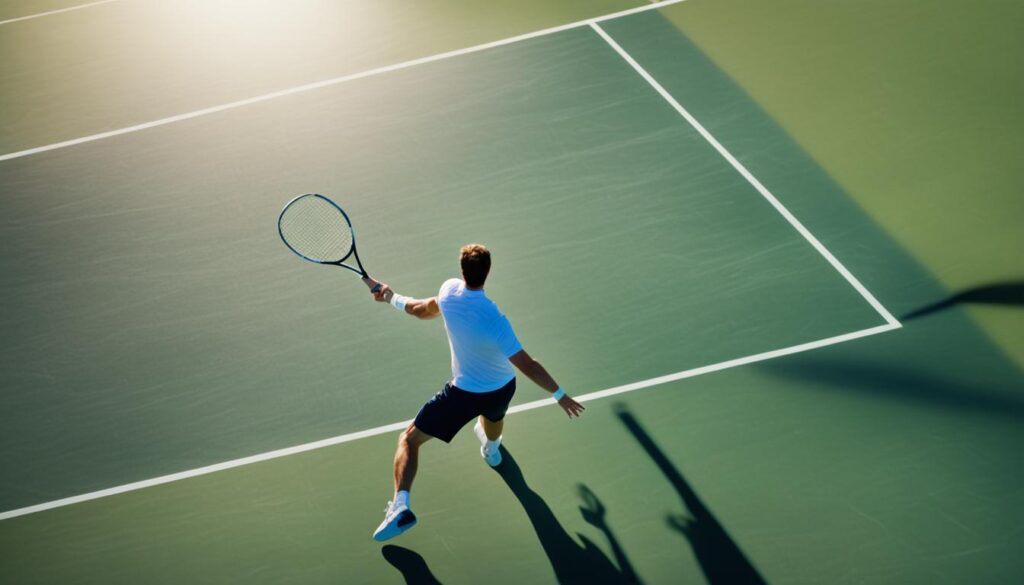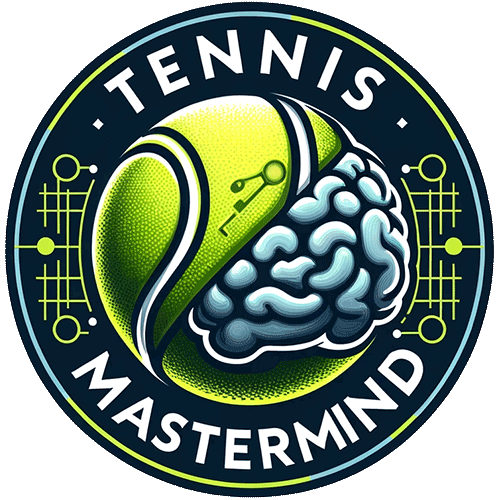Tennis footwork is crucial for beginners who want to improve their game. Often overlooked, footwork is one of the key pillars of the sport that professional players prioritize in their training. By following these five steps, beginners can master tennis footwork and move around the court more efficiently and effortlessly.
Firstly, focus on the split step, which involves being in the air when your opponent strikes the ball, allowing for quick reactions and movement in any direction. Secondly, maintain a wide base with feet outside the shoulders to improve balance and develop the physical ability to move effectively.
Next, take bigger steps to cover more ground quickly. This will enhance movement in any direction and help develop a better rhythm on the court. Remember to work on small adjustment steps before hitting the ball to maintain balance and control.
In the absence of a practice partner, practicing shadow strokes is an effective way to improve tennis footwork. By performing shadow strokes, you can practice different footwork patterns and hone your rhythm and movement on the court.
Lastly, focus on developing rhythm in your footwork. Adjust your movement based on the speed of the ball and arrive at the appropriate time to make contact. Developing rhythm through focused practice and footwork drills can lead to more precise movement, better shot execution, and ultimately, more enjoyable and successful matches.
Key Takeaways
- Tennis footwork is essential for beginners looking to improve their game.
- The split step is crucial for quick reactions and movement on the court.
- A wide base improves balance and agility.
- Taking bigger steps helps cover more ground efficiently.
- Shadow strokes are an effective way to practice footwork patterns.
The Importance of the Split Step in Tennis Footwork
The split step is a crucial element of tennis footwork. It involves being in the air when your opponent strikes the ball, allowing you to quickly react and move in any direction. Many players struggle with the timing of the split step, but by starting it early and being in the air when contact is made, you can enhance your agility on the court. Implementing the split step correctly can make a significant difference in your overall footwork and movement during a match.
Incorporating the split step into your tennis footwork technique is essential for several reasons. Firstly, it helps you anticipate your opponent’s shot and prepares you to react swiftly. When you perform the split step, your body should be balanced and ready to explode in any direction. This allows you to cover more ground and reach the ball with greater ease.
Secondly, the split step is instrumental in maintaining your court positioning. By starting your split step early, you position yourself optimally to move forward, backward, or sideways based on the incoming shot. This ensures that you’re always in the right position to execute your next shot effectively.
The Split Step Technique:
- Stand with your feet shoulder-width apart, knees slightly bent, and weight evenly distributed.
- As your opponent prepares to strike the ball, push off both feet and jump slightly into the air.
- As you land, your feet should be hip-width apart, ready to explosively move in any direction.
Practicing the split step technique can greatly improve your ability to react quickly and move efficiently on the tennis court. Incorporate it into your training sessions and match play to enhance your overall footwork and give you a competitive edge.
In the next section, we’ll explore the importance of maintaining a wide base in tennis footwork. A wide base provides stability and allows you to generate power in your shots. Let’s dive in!
The Importance of a Wide Base in Tennis Footwork
Having a wide and strong base is crucial in tennis footwork. Many players make the mistake of having a narrow base after the split step, which limits their movement and stability on the court. By maintaining a wide base with feet outside the shoulders, players can improve their balance and develop the physical ability to move efficiently.
One way to achieve a wide base is by strengthening the legs. Exercises like single-leg squats and glute bridges can help enhance the wide base and overall footwork in tennis.
Here’s an example of a leg-strengthening routine:
- Single-Leg Squats: Stand on one leg with the other leg extended in front. Slowly squat down as far as you can, keeping the standing knee aligned with your toes. Return to the starting position and repeat for 10-12 reps on each leg.
- Glute Bridges: Lie on your back with your knees bent and feet flat on the ground. Lift your hips off the ground, squeezing your glutes at the top. Lower your hips back down and repeat for 12-15 reps.
- Step-Ups: Find a sturdy step or bench. Step up onto the step with one foot, then step down. Repeat for 10-12 reps on each leg.
- Lateral Lunges: Stand with your feet hip-width apart. Take a wide step to the side with your right foot, bending your right knee while keeping your left leg straight. Push off with your right foot to return to the starting position. Repeat on the other side. Do 10-12 reps on each leg.
By incorporating these exercises into your training routine, you can strengthen your legs, improve your wide base, and enhance your overall tennis footwork.

Taking Bigger Steps in Tennis Footwork
In order to cover more ground quickly and efficiently on the tennis court, it’s important to incorporate bigger steps into your footwork. This allows you to reach the ball more effectively and move in any direction with ease. Many professional players, including Djokovic, Federer, and Nadal, are known for their ability to take big steps and maneuver around the court effortlessly.
Practicing tennis footwork drills that focus on taking bigger steps can greatly improve your movement and overall performance. These drills help to train your muscles and develop the agility needed to cover more ground and reach the ball in optimal positions.
Additionally, incorporating tennis footwork patterns into your training can help to enhance your movement and develop a better rhythm on the court. By practicing specific footwork patterns, such as crossover steps, shuffle steps, and split steps, you can improve your ability to move quickly and efficiently in different directions.
It’s important to note that while taking bigger steps is beneficial, it’s equally important to continue working on small adjustment steps before hitting the ball. This helps to maintain balance, control, and positioning on the court.
“Taking bigger steps in your tennis footwork can make a significant difference in your ability to cover the court and reach the ball effectively.” – Novak Djokovic
Tennis Footwork Drills
Here are some tennis footwork drills that can help you incorporate bigger steps into your training:
- Baseline Sprints: Set up markers at different locations on the baseline and sprint to each marker, focusing on taking big steps.
- Ladder Drills: Use an agility ladder to practice different footwork patterns, emphasizing larger steps.
- Court Coverage Drill: Have a partner hit balls to different areas of the court, and practice moving quickly to each ball with bigger steps.
By regularly incorporating these drills into your training routine, you can improve your footwork and enhance your performance on the tennis court.
Comparison of Tennis Footwork Patterns
| Tennis Footwork Pattern | Description | Benefits |
|---|---|---|
| Crossover Steps | Steps where one foot crosses behind the other. | – Improve lateral movement – Enhance quick direction changes – Maintain balance during wide shots |
| Shuffle Steps | Side-to-side stepping motion. | – Increase agility on the court – Move quickly to reach wide or short balls – Maintain balance during quick changes in direction |
| Split Step | Jumping and landing with feet shoulder-width apart. | – Improve reaction time – Enhance explosiveness in movement – Prepare for shots from opponents |
By incorporating these tennis footwork patterns into your training sessions, you can develop a well-rounded footwork technique and improve your overall performance on the court.
Practicing Shadow Strokes for Tennis Footwork Improvement
Shadow strokes are an essential part of any tennis player’s training regimen when aiming to enhance their footwork. These exercises prove particularly beneficial for solo practice sessions, allowing players to improve various footwork patterns while developing better rhythm and movement on the court.
Dedicating time to practicing shadow strokes during regular training sessions and before tournaments can significantly enhance your footwork, maximizing your performance during matches. Even professional players, such as Serena Williams and Rafael Nadal, incorporate shadow strokes into their warm-up routines to refine their footwork skills and maintain optimal performance levels.
While performing shadow strokes, imagine yourself in a real match scenario, visualizing the ball coming towards you, and execute the appropriate footwork pattern and stroke. By leveraging these mental visualizations and executing precise footwork movements, you can reinforce the muscle memory required for efficient court coverage.
These exercises are excellent for developing agility, balance, and coordination, as they require controlled movement without the actual presence of a ball. By practicing shadow strokes consistently, you can enhance your footwork technique and become more adept at transitioning around the court.
Additionally, shadow strokes allow you to work on specific footwork patterns that may need improvement. By isolating and repeating these movements, you can target areas of weakness and make necessary adjustments to enhance your overall footwork performance.
Benefits of Shadow Strokes in Tennis Footwork Improvement
Practicing shadow strokes offers several key benefits that can elevate your tennis game:
- Improved footwork efficiency: Shadow strokes allow you to focus solely on your footwork patterns, enabling you to identify and correct any inefficiencies in your movement. This enhanced footwork efficiency translates to more effective court coverage and quicker response times during matches.
- Enhanced coordination and balance: Shadow strokes help improve your coordination and balance by promoting synchronized movements between your upper and lower body. This synchronization is crucial for executing strokes with proper technique and maintaining stability throughout intense rallies.
- Increased agility and speed: Regular shadow stroke practice can lead to improved agility and speed on the court. By training your muscles to perform precise footwork, you can move swiftly and explosively, giving you an edge over your opponents.
Mastering shadow strokes requires dedicated practice and focus. Incorporate these exercises into your regular training routine, either as part of your warm-up or as a standalone footwork session, to reap the rewards of improved footwork and ultimately elevate your tennis game.

| Benefits of Shadow Strokes in Tennis Footwork Improvement |
|---|
| Improved footwork efficiency |
| Enhanced coordination and balance |
| Increased agility and speed |
Developing Rhythm in Tennis Footwork
Mastering the art of tennis footwork goes beyond just physical movements. It also involves developing a sense of rhythm on the court, which is crucial for timing and tempo. By adjusting your movement according to the speed of the ball and arriving at the right moment, you can significantly improve your footwork and overall performance.
To develop rhythm in tennis footwork, it is essential to move quickly when the ball is fast and adopt a more deliberate pace when it’s slower. By syncing your footwork with the rhythm of the game, you can enhance your timing and execute shots with precision. This not only allows for better shot selection but also improves your ability to anticipate and respond to your opponent’s moves.
To hone your rhythm in tennis footwork, incorporate footwork drills and focused practices into your training routine. These drills can help you develop muscle memory, improve your reaction time, and fine-tune your footwork. By consistently working on your rhythm, you can boost your movement speed, ensure better shot execution, and experience more enjoyable and successful matches on the court.
Remember, developing rhythm in tennis footwork is a skill that requires practice and dedication. By focusing on timing, tempo, and syncing your movements with the game’s rhythm, you can take your footwork to the next level and elevate your performance on the court.




